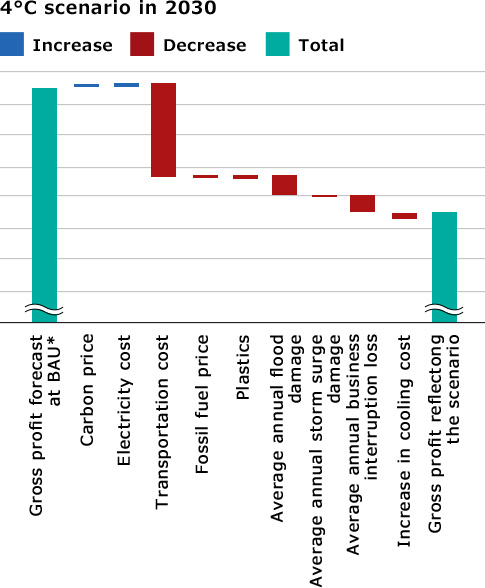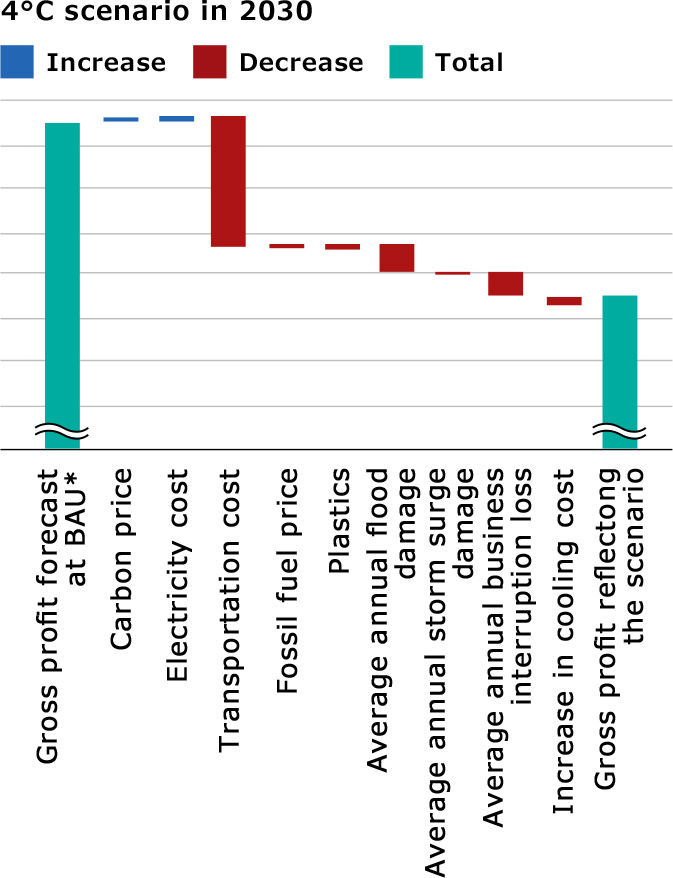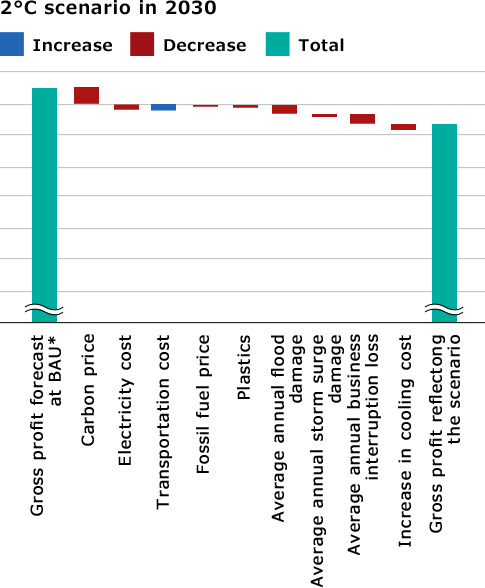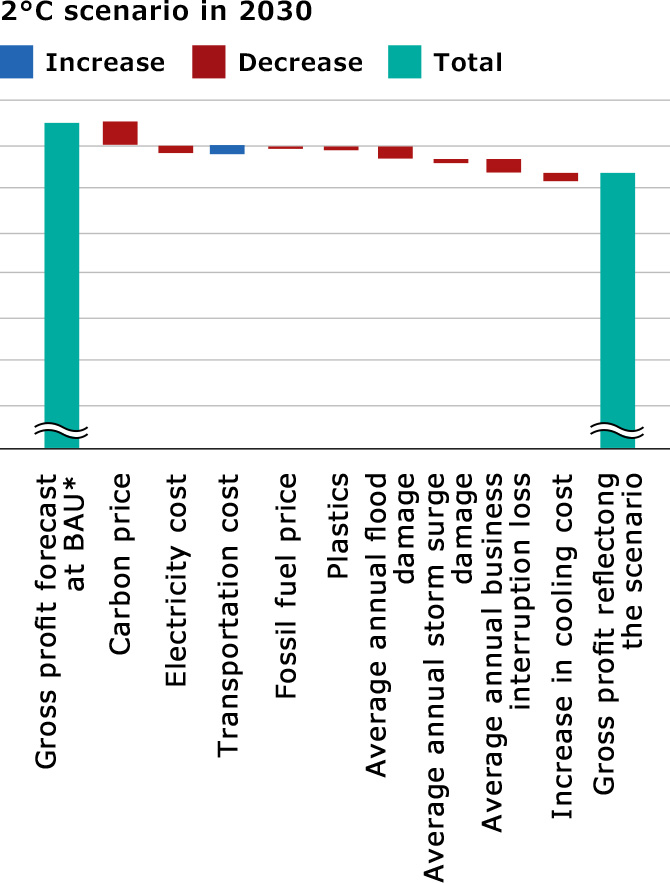

Environment
Environment
Thinking about the environment
The SCROLL Group will set goals in line with the following environmental activity policies for the environmental load that may occur in corporate activities,and will contribute to reducing the environmental load of the entire value chain through its business.
Environmental activity policy
(1)We will promote the provision of safe and secure products and services with less environmental impact.
(2)We will promote the reduction of waste and greenhouse gas emissions.
(3)We will promote the use of environment-friendly resources and the recycling of resources.
(4)We will promote environmental communication, such as educating employees and promoting understanding of our business partners.
(5)We will regularly verify and announce the results of our goals and promote continuous improvement of environmental performance.
CO₂ reduction targets / measures
Reduction target
The SCROLL Group aims to reduce CO₂ emissions from Scope 2 (*) by 50% or more by FY2030 compared to FY2020.
*Indirect discharge due to the use of electricity, heat, and steam supplied by other companies.
In the Group, CO₂ emissions from distribution centers and offices fall under this category.
Reduction measures
We will implement the following measures to reduce CO₂ emissions.
■Installation of solar power generation system
We are planning to install a solar power generation system in the Logistics center. We will conclude a power sales contract (PPA) with Electric Power company to promote the purchase of renewable energy generated by solar power generation systems.
■Purchasing CO₂ Free Electricity
We will proceed with efforts to purchase electricity derived from renewable energy from Electric Power company.
■Inverter control of air-conditioning cooling equipment
We will reduce the amount of electricity by introducing control equipment to the air-conditioning cooling equipment of SCL Hamamatsu Nishi.
■Switching to LED lighting
We will change the lighting in our facilities to LEDs and contribute to the reduction of CO₂.
Efforts to reduce environmental impact through business activities
We will proactively reduce the environmental burden through our business activities.
■Expansion of SDGs-related products
We will promote the development of environmentally friendly products, products that inherit Japanese traditions and technologies, and products that can contribute to society.
Goal
50% of SDGs-related products by FY2025 (apparel products)
■Reducing the amount of plastic materials used
We will promote the switch to environmentally friendly packaging materials.
Goal
65% reduction in plastic material usage by FY2030 (compared to FY2021)
■Reduction of paper usage
We will reduce the amount of paper used by reducing the number of copies and pages of the catalog and promoting the transition to the WEB catalog.
Goal
25% reduction in paper usage by FY2030 (compared to FY2021)
Disclosure based on the Task Force on Climate-related Financial Disclosures (TCFD)
The Group considers “reduction of environmental impact” to be a materiality and has initiated a scenario analysis of the financial impact of climate change in line with TCFD recommendations. We will continue to enhance the content of our disclosures and promote initiatives toward a decarbonized society.
Governance
Recognizing climate change as one of the key issues affecting management, the Board of Directors identifies materiality and determines the direction of measures to resolve it. To promote activities to reduce environmental impact, including addressing climate change, a Sustainability Committee chaired by the Representative Director will be established in FY2022, and, about twice a year, the committee will work with business divisions to set targets, monitor the progress of the plan, and evaluate the implementation of the plan. In addition, the contents of the Committee meetings will be reported to the Board of Directors to ensure that the supervision of the Board of Directors is conducted appropriately.
Risk management
Risks are identified and assessed with the business divisions as risk owners. In addition, a “General Risk Management Activities” Office (RM Office) has been established as the office for the Internal Control Committee, and it supports responding to risks in business divisions. These activities are audited by the Internal Audit Department and reported to the Audit and Supervisory Committee and the Board of Directors. We have established a system that enables continuous monitoring by ascertaining the general risks related to business activities and the risks peculiar to the SCROLL Group.
In the future, the Sustainability Committee will work with the RM Office to identify and assess risks related to climate change issues while integrating them into company-wide risk management.
Strategy
●Risks and Opportunities A scenario analysis was conducted to properly identify the transitional and physical risks/opportunities related to climate change for the Group’s main Mail-order, Solutions, and E-commerce businesses. In considering the impact of each climate change risks/opportunities for our business, we considered risk/opportunity items from raw-material procurement to transportation/storage to product use, and used the 2°C and 4°C scenarios published by international organizations to determine the impact on the SCROLL Group in 2030.
| Risk Items | Business Impact | ||||
|---|---|---|---|---|---|
|
|
Medium classification | Small classification | Time axis | Consideration: risks | Consideration: Opportunities |
| Transition Risks | Policy and Regulation | carbon pricing(carbon taxes) | Medium~Long Term | Increased costs related to electricity and fuel consumption at logistics facilities and business sites, etc. | ー |
| Plastics Regulation | Medium~Long Term | Regulations on plastic packaging introduced and costs incurred in responding to them | Increased demand from companies wishing to use ethical logistics services through the use of non-plastic and biomass-derived packaging materials | ||
| Products and Services | Change in demand for key products | Medium~Long Term | Increased consumer awareness of sustainability has led to longer usage periods for clothing and accessories, resulting in lower sales volumes and increased competition | Growing consumer awareness of sustainability has increased the importance of ethical consumption-conscious products, leading to higher sales volumes | |
| Customer’s Behavioral Change | Medium~Long Term | Decreased demand for products that do not take environmental impact into account or do not clearly state that they do so | Increased demand for products with low environmental impact | ||
| Market | Changes in energy costs | Short~Long Term | Rising transportation costs paid to logistics companies due to rising fossil fuel prices | ー | |
| Reputation | Changes in energy costs | Medium~Long Term | If the company is evaluated as being reluctant to make environmental efforts, the brand image will be tarnished and sales volume will decrease | 【Solutions Business】 Increased demand for CRM support due to diversifying customer needs based on consumers’ growing environmental awareness, etc. |
|
| Physical Risks | Acute | Increasing severity of natural disasters, typhoon,torrential rain,sediment-related disaster,Storm Surge etc |
Medium~Long Term | ・Decrease in revenue due to supply chain disruptions and delays in product shipments ・Increased costs of raw materials, transportation, and catalog paper due to extreme weather conditions |
【Mail-order and E-commerce Business】 Extreme weather conditions have intensified, reducing the frequency of outings and increasing the number of mail-order users. 【Solutions Business】 Multiple logistics bases allow for response to large-scale disasters and unforeseen events, reducing risk and costs. 【E-commerce Business】 Demand for emergency supplies and kits is increasing due to concerns about severe extreme weather events. |
| Chronic | Average temperature increase | Medium~Long Term | ・Demand for seasonal products changes due to hot summers and mild winters ・Increased cost of maintaining product storage environment due to changes in temperature and humidity |
ー | |
●Business Impact In the case of the 4°C scenario, in addition to physical damage from severe disasters such as typhoons and floods, the impact of transportation costs due to increased oil demand was estimated to be relatively high. On the other hand, for the 2°C scenario, the carbon price impact was estimated to be relatively large. Regarding the risks and opportunities that can be estimated for both scenarios, the impact is limited in both cases, but we will continue to monitor the risks and opportunities, taking into account the results of the estimates obtained this time.




※Gross profit forecast at BAU (business as usual) : Gross profit figures in 2030 using statistics from past performance.
●Business Impact and Future Initiatives
We conducted a scenario analysis of our group’s three main businesses that are considered to be significantly impacted by climate change, and we found that although transportation costs are significantly impacted by the increased demand for oil under the 4°C scenario, no significant impact was found for the other quantitatively analyzed items.
In order to confirm the impact of climate change on our entire business, we plan to conduct analyses from both transitional and physical perspectives, further identify and organize areas of significant impact, and consider specific future response policies, based on priority, for areas that require action within our company as a whole.
Indicators and Targets
●CO₂ emissions in Scope 1 and 2*
In FY 2023, Scope 1 and 2 CO₂ emissions totaled 2,865 tons.
With the goal of reducing CO₂ emissions in Scope 2,by 50% or more by 2030 compared to FY 2020, we will implement the following initiatives at our logistics facilities and office buildings, etc., which are our assets.
・Installation of solar power generation systems at logistics centers
・Purchasing of CO₂-free electricity
・Using inverters for air conditioning and cooling
・Switching to LED lighting
●CO₂ emissions in Scope 3*
In FY 2023, Scope 3 CO₂ emissions were 172,418 tons.
In the future, we will also consider setting targets for emissions in the value chain (Scope 3).
* Scope 1: Direct greenhouse gas emissions by businesses themselves.
Scope 2: Indirect emissions associated with the use of electricity, heat, and steam supplied by other companies.
Scope 3: Indirect emissions besides scopes 1 and 2.
See data for scopes 1, 2, and 3 in the annual report.


